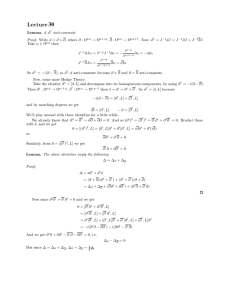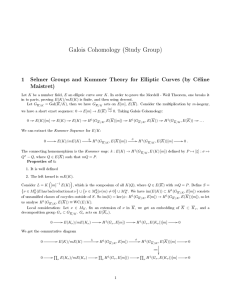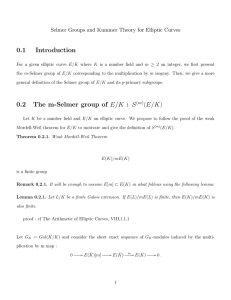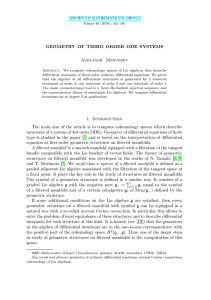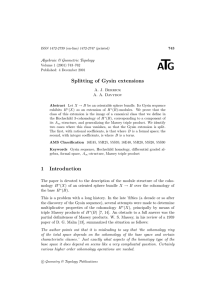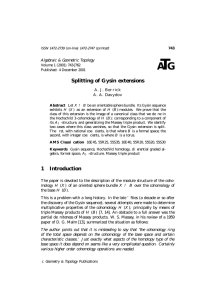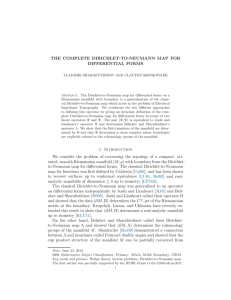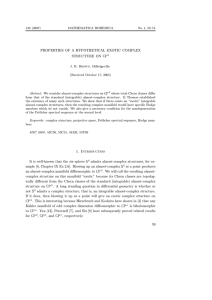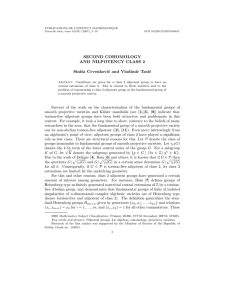Toda’s realization theorem Haynes Miller June, 2007
advertisement
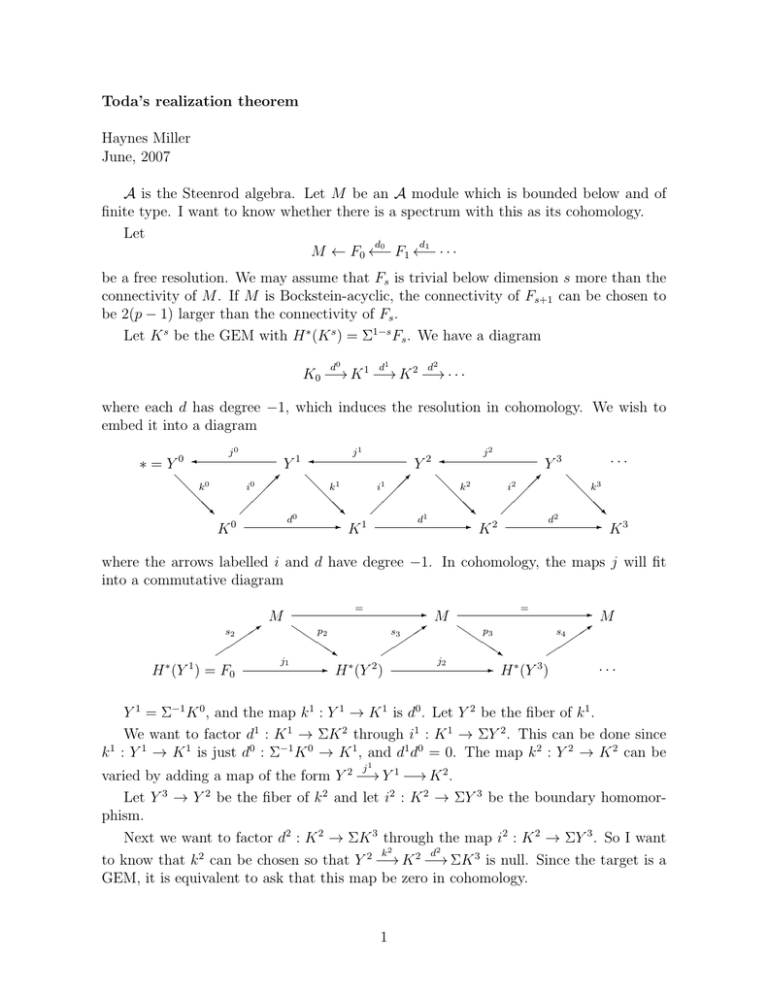
Toda’s realization theorem Haynes Miller June, 2007 A is the Steenrod algebra. Let M be an A module which is bounded below and of finite type. I want to know whether there is a spectrum with this as its cohomology. Let d0 d1 M ← F0 ←− F1 ←− ··· be a free resolution. We may assume that Fs is trivial below dimension s more than the connectivity of M . If M is Bockstein-acyclic, the connectivity of Fs+1 can be chosen to be 2(p − 1) larger than the connectivity of Fs . Let K s be the GEM with H ∗ (K s ) = Σ1−s Fs . We have a diagram d0 d1 d2 K0 −→ K 1 −→ K 2 −→ · · · where each d has degree −1, which induces the resolution in cohomology. We wish to embed it into a diagram j0 ∗=Y0 Y1 i0 @ k0 @ @ R @ d0 K0 @ k1 @ @ R @ - j1 j2 Y2 i1 d1 K1 @ k2 @ @ R @ - ··· Y3 i2 d2 K2 @ k3 @ @ R @ - K3 where the arrows labelled i and d have degree −1. In cohomology, the maps j will fit into a commutative diagram = M s2 Q 3 H ∗ (Y 1 ) = F0 j1 3 s3 p2 Q QQ s - H ∗ (Y 2 ) M j2 = 3 s4 Q p3 Q QQ s - H ∗ (Y 3 ) M ··· Y 1 = Σ−1 K 0 , and the map k 1 : Y 1 → K 1 is d0 . Let Y 2 be the fiber of k 1 . We want to factor d1 : K 1 → ΣK 2 through i1 : K 1 → ΣY 2 . This can be done since 1 k : Y 1 → K 1 is just d0 : Σ−1 K 0 → K 1 , and d1 d0 = 0. The map k 2 : Y 2 → K 2 can be j1 varied by adding a map of the form Y 2 −→ Y 1 −→ K 2 . Let Y 3 → Y 2 be the fiber of k 2 and let i2 : K 2 → ΣY 3 be the boundary homomorphism. Next we want to factor d2 : K 2 → ΣK 3 through the map i2 : K 2 → ΣY 3 . So I want k2 d2 to know that k 2 can be chosen so that Y 2 −→ K 2 −→ ΣK 3 is null. Since the target is a GEM, it is equivalent to ask that this map be zero in cohomology. 1 Since coker(F1 → F0 ) = M , the long exact sequence for the cofibration sequence Y 2 → Y 1 → K 1 gives exactness of the top row in the diagram 0 - p M - H ∗ (Y 2 ) - Σ−1 ker d0 - 0 3 6 k2 d3 −1 Σ F4 - −1 Σ F3 d2 - ∗ 2 −1 H (K ) = Σ F2 ? d1 - −1 Σ F1 The composite d1 d2 is zero, and the right vertical is a monomorphism, so the composite k2 d2 factors through the inclusion p : M → H ∗ (Y 2 ) by a map c : Σ−1 F3 → M . Since pcd3 = k3 d2 d3 = 0, the map c is a cocycle representing a class in Ext3,1 A (M, M ) If we assume that this group is zero, then c is a coboundary, which is to say that it factors through d2 : Σ−1 F3 → H ∗ (K 2 ) = Σ−1 F2 by a map b : H ∗ (K 2 ) → M . The map pb : Σ−1 F2 → H ∗ (Y 2 ) is the effect in cohomology of exactly the sort of map by which we are allowed to alter k 2 ; and pbd2 = pc = k2 d2 , so if we replace k2 by k2 − pb, then k2 d2 = 0, as desired. Notice that this choice of k2 then factors through the surjection Σ−1 F2 → Σ−1 ker d0 , and thus splits the top sequence in the diagram. Let s2 : H ∗ (Y 2 ) → M be the corresponding splitting of p. So d2 factors as d2 = k 3 i2 . The map k 3 : Y 3 → K 3 can be varied by any map of the j2 form Y 3 −→ Y 2 −→ K 3 . Let j 3 : Y 4 → Y 3 be the fiber of k 3 : Y 3 −→ K 3 . Next we want to factor d3 : K 3 −→ ΣK 4 through i3 : K 3 −→ ΣY 4 ; that is, we want k3 d3 to know that k 3 can be chosen so that Y 3 −→ K 3 −→ ΣK 4 is null. For this we need to analyze the cohomology of Y 3 . We have a diagram 2 0 H 6 HH H HH HH H j H Σ−2 ker d1 M 6 HH 6 s2 −1 ∗ 2 Σ F2 = H (K ) ∗ H HH 2 H (Y ) - - ∗ Σ−2 F3 HH H 3 H (Y ) - d2 HH j H ? −2 Σ F2 = H ∗ (Σ−1 K 2 ) H HH 6 H HH k2 HH j −1 Σ k2 - 6 H HH HH j Σ−2 ker d0 ker d0 H 6 H ∗ (Σ−1 Y 2 ) HH H HH H 0 HH j H 0 in which the straight lines are exact. Chasing it around, we find that the top row in the following sequence is exact. 0 - p M - H ∗ (Y 3 ) - Σ−2 ker d1 - 0 3 6 k3 −2 Σ F5 d4 - −2 Σ F4 d3 - ∗ 3 −2 H (K ) = Σ F3 ? d2 - −2 Σ F2 c p We are at the inductive step; the composite k2 d3 factors as Σ−1 F4 −→ M −→ H ∗ (Y 3 ), and c is a cocyle, determining an element of Ext4,2 A (M, M ) If this cohomology class vanishes, the map k3 can be altered so that k3 d3 = 0, and the process continues. 3


